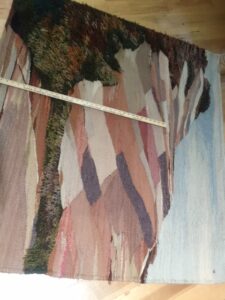 JS sent me a 1980’s Polish handwoven and artist designed midcentury modern tapestry titled “Na Stoku,” meaning “On Slope.” At fifty-four by fifty inch. She wonders about the wool craft piece, and how it fits into the history of textile art.
JS sent me a 1980’s Polish handwoven and artist designed midcentury modern tapestry titled “Na Stoku,” meaning “On Slope.” At fifty-four by fifty inch. She wonders about the wool craft piece, and how it fits into the history of textile art.
At the first Lausanne International Tapestry Biennial in 1962 polish weavers made a huge splash. The designers of the works actually wove their piece. Previous to this, an artist designed the work, and had the piece woven at a workshop.
Why did this fusion happen in Poland?
World War II leaving Poland in ruins turned out fortuitous for textile crafts. Artists, problem-solvers by nature, needed to figure out HOW to create without the materials (medium) needed. Necessity indeed became the mother of invention, and created new world for textile artists. Anyone who owned a piece of macrame in 1970 will attest. Polish artists created with what they HAD.
Polish regime, unfriendly to art in the 1950s-1960s, made art materials expensive and unavailable. So Polish artists found ways of finding materials to create with. In the case of weavers, they used simple yarns, or sometimes sisal. They created a new style of abstraction that didn’t require fine work in thick rustic handmade wool. This type of tapestry, more akin to sculpture, displayed dimension on a two dimensional plane.
New Tapestry
Traditional weaving in Poland, along with many other hand crafted folk art forms, was taught in school. So, they knew the FORM, but the materials needed re-inventing. This led to a new LOOK, called New Tapestry, so sought after by midcentury modern collectors today. In some cases the images appeared pictorial, as in JS’s piece. Oftentimes the scenes went out on an “abstraction limb” and THOSE abstract or semi-abstract works are desirable today.
The Crafts Movement got underway in the mid-20th century. Small villages created beautiful Swedish furniture, and small centers in Poland designed and created wonderful textiles. Few people then appreciated that handmade quality, but collectors with “the eye” did. Today, of course, we have a respect for that originality we call the “proximity to the artist’s hand.” The concept of the studio-designer-craftsman came out of this era, and America followed suit.
“Out of the way” artist’s colonies became hotbeds of this new tapestry. These included remote villages on the East Coast, Scottish workshops, and Australian guilds, centers in Northern California, and small towns in the Rockies.
1978 saw the exhibit 22 Polish Textile Artists in Fort Collins CO. This show featured works with blocks of color, sculptural techniques of piling on yarn, or cutting yarn for texture, as in JS’s piece, and in a large, large scale.
If you remember the 1970s
The American Southwest became newly re-discovered. Weavers traveled from San Francisco to New Mexico to study with Native American weavers. Others setup a small center in remote Oregon for weaving New Textiles.
At the foundation all textile manufactory sits the French monolith Gobelins, tapestry weavers to the LOUIS king line since the beginning of the 16th Century. Polish artists termed the style of their work “Gobelins” as is stated on the verso label of JS’s work.
Some Polish labels of the midcentury bear the image of a rooster, standing for Cepelia, the famous Polish Arts and Handcrafts Foundation. Setup after WWII in 1949, Cepelia supports Polish traditional handwork and crafts-artists with no outlet and little income. As Polish handwork became essential to Polish ethnographic character the Foundation distributed the work. Some of the artists they supported TODAY are recognized as textile masters. Among those people who love midcentury modern tapestries, Piotr Grabowski’s work became valued, and collected for $5,000 or more.
Weavers of repute sell in auction houses in Europe for high figures as such handicraft became recognized as ‘fine art.’ However, JS’s piece bears a name I didn’t find, and is also representational, and not abstracted in the flattened picture plane so valued today. I put the value at $500.
A 2019-2020 show 19th and 20th Century Tapestries, at none other than the State Hermitage Museum, St Petersburg, indicates a resurgence of interest in the form.
Pingback: Olympic Art - Elizabeth Appraisals
Pingback: Meaningful Hindu Temple Shrine Tapestry - Elizabeth Appraisals